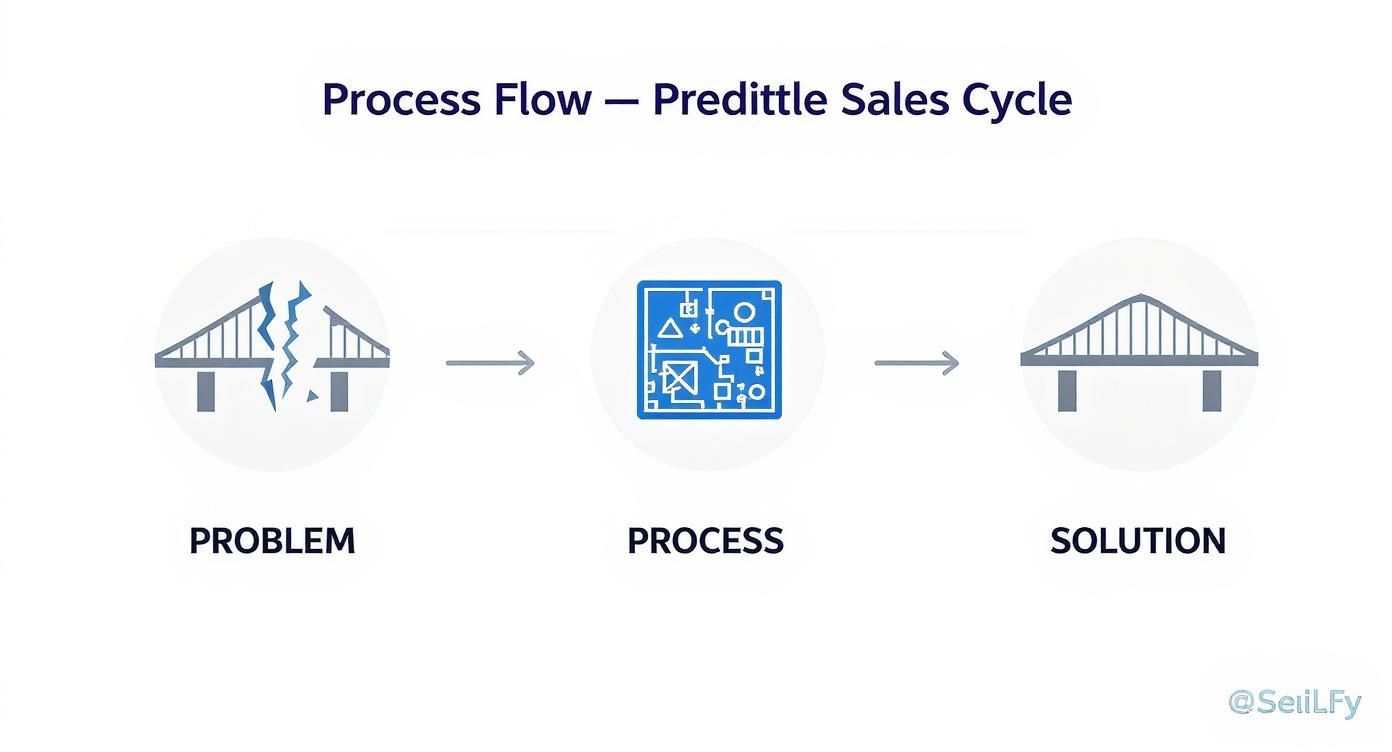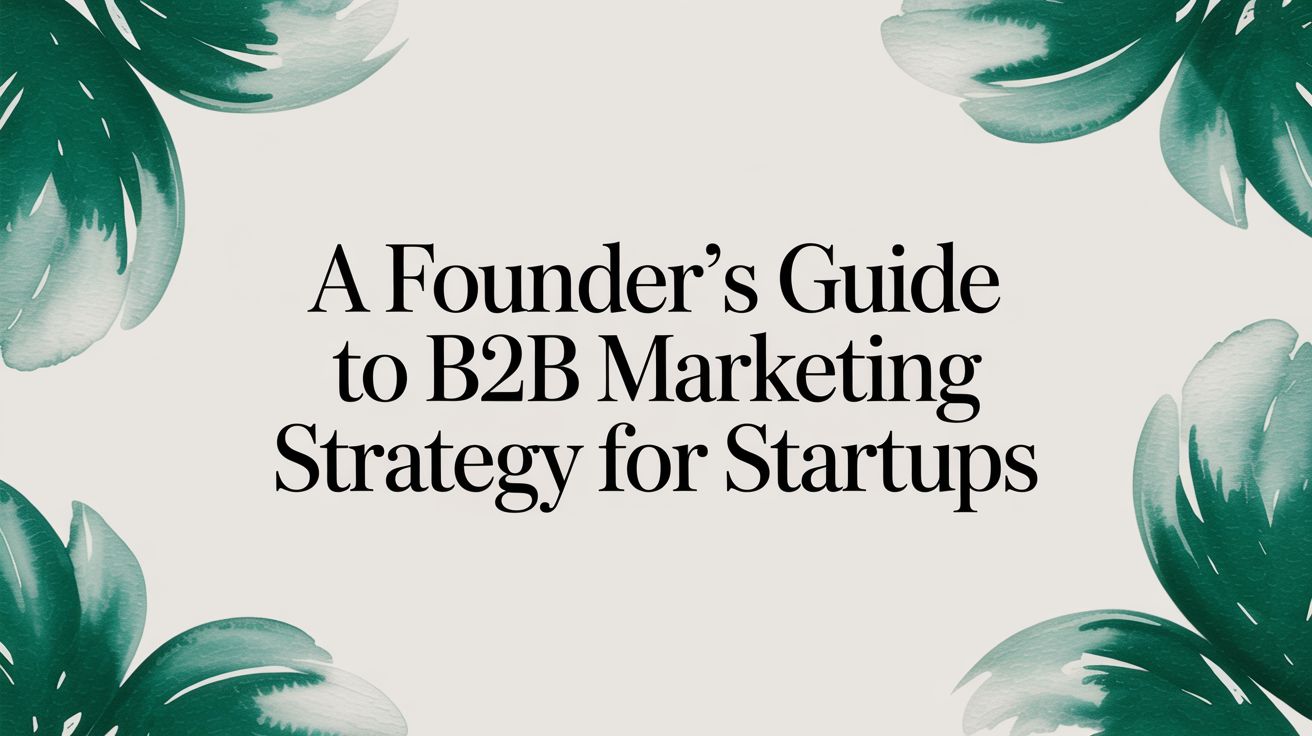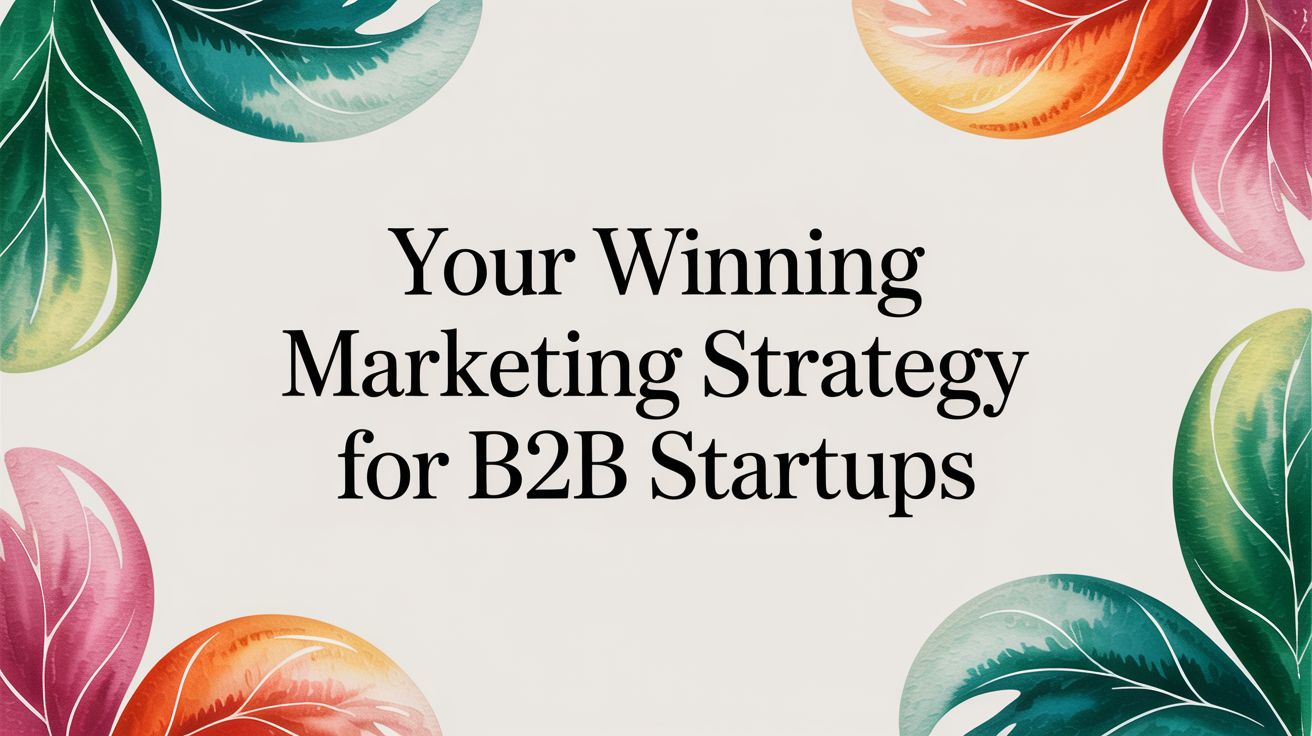Mastering the B2B Sales Cycle for SaaS Startups
October 31, 2025

The B2B sales cycle is the repeatable, step-by-step process your team follows to turn a potential business prospect into a paying customer. It’s a structured journey, but it’s fundamentally different from selling directly to consumers. B2B sales typically involve multiple decision-makers, a much longer consideration period, and a sharp focus on solving complex business problems.
Your Blueprint for a Predictable B2B Sales Cycle
Imagine trying to build a bridge without a blueprint. You might have the materials and a dedicated crew, but without a clear plan, the whole project descends into chaos. It’s unpredictable, inefficient, and likely to fail. An undefined sales process is no different; it leaves your startup’s growth to chance, leading to inconsistent revenue and a lot of wasted effort.
A well-defined B2B sales cycle is the architectural blueprint for your revenue engine. It transforms random sales activities into a systematic, repeatable journey that guides potential customers from acknowledging a core problem to seeing your SaaS solution as the definitive answer.
This structured approach is what separates high-growth startups from the ones that just spin their wheels. It brings clarity to your sales team, creates a consistent experience for your buyers, and—most importantly—makes your revenue forecastable.
The Foundation of Scalable Growth
For B2B SaaS founders, getting this process nailed down early is absolutely crucial. A documented sales cycle ensures that as you hire more reps, every new team member understands the exact steps required to find, engage, and close deals. This consistency is what keeps valuable leads from falling through the cracks and dramatically shortens the learning curve for new hires.
Without this framework, your team is just guessing. With it, you're handing them a map that shows the most efficient path to success. A solid process doesn’t just help close this month's deals; it builds the very foundation of a scalable business.
A predictable sales process turns aspiration into a formula. It's the critical link between a great product and a great business, ensuring that every effort is deliberate, measurable, and aimed directly at sustainable growth.
Visualizing the Journey
The infographic below brings this journey to life, showing how a structured process connects a customer's initial problem to your ideal solution.

This visual drives home the point that a successful cycle is built on a clear process—the blueprint—that methodically closes the gap between your prospect's needs and what your solution delivers. Mastering each stage of this journey is the first step toward building a powerful and predictable revenue machine. You can learn more about building a winning framework in our complete guide to developing a B2B sales strategy.
Finding and Qualifying Your Ideal Customer

The journey to a successful B2B sale doesn't start with a killer pitch. It starts with a deep, almost obsessive, understanding of who you're trying to help.
Too many B2B startups waste precious time and cash casting a wide net, hoping to catch any customer that swims by. This isn't just inefficient; it’s a recipe for burnout and a completely unsustainable way to grow a SaaS business.
The first and most critical phase of your B2B sales cycle is all about precision. It's about finding the right companies—and the right people inside them—whose problems you are uniquely built to solve. This initial stage sets the entire trajectory for the deal. Get it right, and everything else flows.
By focusing on quality over quantity from the beginning, you stop your sales team from chasing dead-end leads. This ensures every single conversation is with a prospect who has the real potential to become a long-term, high-value partner.
Defining Your Ideal Customer Profile
Before you can find your ideal customers, you have to know exactly who they are. This goes way beyond basic firmographics like industry or company size. An Ideal Customer Profile (ICP) is a clear, detailed description of the perfect-fit company for your SaaS solution.
Think of your ICP as the North Star for your entire go-to-market effort. It guides every single decision, from the blog posts you write to the outreach emails you send. A strong ICP comes from analyzing your best existing customers or, if you’re just starting out, making an educated guess about which businesses will get the most game-changing value from your product.
To build an ICP that actually works, dig into these factors:
- Company Size and Revenue: At what scale does the problem you solve become truly painful?
- Industry or Niche: Are there specific verticals where your solution isn't just a nice-to-have, but an absolute necessity?
- Technology Stack: Do they use complementary tools (like Salesforce or HubSpot) that make adopting your solution a no-brainer?
- Geography: Are there specific regions you’re best equipped to serve right now?
Once this profile is locked in, identifying high-potential prospects becomes exponentially easier.
The Art of the Discovery Dialogue
With a crystal-clear ICP, the next step is qualification. It’s tempting to treat this like a simple checklist, but a truly effective qualification process is a conversation, not an interrogation. This is your chance to step into a prospect's world and see if there's a genuine fit.
The goal is to shift from a monologue about your product to a dialogue about their challenges. The modern B2B buyer is more informed than ever. A typical B2B purchase involves multiple decision-makers, and a significant portion of their research is done online before they ever speak to a sales rep. This is a massive shift—buyers are now empowered and self-educated.
Your first conversation should feel like a consultation, not a sales pitch. The objective is to diagnose their problem so accurately that your solution becomes the obvious and necessary prescription.
A Framework for Qualification
To bring some structure to these discovery conversations, most successful sales teams use a framework. The BANT framework, while established, remains a simple and powerful tool for this purpose:
- Budget: Can they actually afford your solution? This isn't just about asking for a number; it's about understanding how they allocate funds for new tools and what value they need to see to justify it.
- Authority: Are you talking to the ultimate decision-maker, or an influencer who will champion your cause? Mapping out the key players in the buying committee is crucial.
- Need: What is the specific, urgent pain point they are trying to solve? This is the absolute core of the entire deal. No pain, no sale.
- Timeline: How soon do they need to have a solution in place? Urgency is a powerful indicator that you're talking to a serious buyer.
Using a framework like BANT ensures your team invests its valuable time on leads with the highest potential to close, accelerating the entire B2B sales cycle from the very first conversation.
Nurturing Leads and Presenting Your Solution
Once you’ve got a qualified lead, the initial sprint is over. Now the real race begins. This is where the most successful B2B SaaS startups pull away from the pack—they get that the time between qualifying a lead and closing the deal isn't for sitting on your hands. It's an active, deliberate process of building rock-solid trust and demonstrating undeniable value.
This part of the B2B sales cycle is all about nurturing. Your job is to be a trusted guide, not a pushy salesperson. You need to educate, offer insights, and consistently deliver value long before you even think about asking for the sale. Jump the gun with a demo or proposal, and you can instantly shatter the fragile trust you've just started to build.
The goal here is to shift their perception of you from just another vendor to an indispensable advisor. This takes a real commitment to understanding their world and sending them personalized content and messages that hit home.
From Prospect to Partner: The Art of Nurturing
Lead nurturing is how you maintain consistent, meaningful communication with prospects who aren't quite ready to buy. It's about staying top-of-mind by simply being helpful. And it pays off—companies that master lead nurturing generate 50% more sales-ready leads at a 33% lower cost. This isn't about blasting out generic weekly newsletters; it's a finely-tuned strategy.
Effective nurturing in a B2B setting looks like this:
- Personalized Content: Don't send a generic blog post. Share a case study from a company just like theirs. Send an article that directly tackles a pain point they mentioned on your discovery call. Give them data-driven reports that make them see their own challenges in a new light.
- Value-Driven Conversations: Your check-in emails shouldn't just ask if they're "ready to talk yet." That's a dead end. Instead, offer a new insight or a helpful resource that keeps the conversation moving forward and reinforces your expertise.
- Multi-Channel Engagement: Connect with them on LinkedIn. Like and comment on their company's posts. Show a genuine interest in their business and their industry. This simple effort reinforces that you see them as more than just a line item in your CRM.
This sustained, value-first approach builds massive credibility. It positions your solution as the only logical choice when the timing is right. You're not just another option on a list; you're the expert who's been guiding them all along. For a deeper dive on keeping leads engaged, check out these proven strategies for B2B demand generation.
Crafting a Presentation That Resonates
After you've methodically nurtured that relationship, the time will come to finally present your solution. This is a make-or-break moment in the B2B sales cycle. A great presentation doesn't just list features; it tells a compelling story that connects your product directly to the prospect's biggest headaches.
Your presentation should be the grand finale of everything you've learned during discovery and nurturing. This is your chance to paint a vivid picture of their future success—a future made possible by your SaaS. Ditch the generic, one-size-fits-all pitch deck. Every single slide, every talking point, must be tailored to the specific challenges and goals of the people in that room (or on that Zoom call).
The most powerful product presentations aren't about your product at all. They are about the customer's problem, their aspirations, and the clear, tangible transformation your solution will deliver for their business.
Storytelling Over Feature-Listing
To make your presentation stick, you need to structure it like a story. And every great story has a beginning, a middle, and an end.
- The Beginning (The Problem): Kick things off by restating their challenges, using their own words. Show them you've been listening intently. This builds immediate rapport and confirms you actually understand their world.
- The Middle (The Solution): Now, introduce your product—not as a collection of features, but as the hero of the story. For every feature you demo, immediately tie it back to a specific pain point they have. Always use the "so what?" test. If you mention a feature, explain so that they can achieve a specific, desirable outcome.
- The End (The Transformation): Wrap up by painting a clear picture of what success looks like on the other side. Use hard data, relevant case studies, or a projected ROI to illustrate the tangible business results they can expect. This is the "happily ever after" that shows them what life will be like after they choose you.
By focusing on their story, you shift the dynamic from a technical demo to a strategic business discussion. This is how you stop being seen as just another vendor and solidify your role as a true partner in their growth.
Navigating Objections and Closing the Deal
This is where the magic happens. After weeks—sometimes months—of demos, nurturing, and presentations, you’ve reached the final stage of the B2B sales cycle. It’s the exhilarating, high-stakes moment where all your hard work either solidifies into a signed contract or unravels at the last minute.

Many sales reps freeze up when they hear an objection, seeing it as a red flag that the deal is dead. But that’s a rookie mistake. A B2B objection isn’t a rejection; it’s a request for more information. It’s a clear signal your prospect is actually engaged, seriously considering your solution, and needs your help connecting the last few dots.
So, when a prospect voices a concern, don’t back down. Lean in. They're inviting you to prove your value one last time. Shifting your mindset to see objections as opportunities is the first step toward becoming a confident closer who guides prospects to a decision that feels right for everyone.
Turning Roadblocks into Opportunities
In B2B SaaS, objections almost always fall into a few familiar buckets. Knowing these categories ahead of time lets you prepare empathetic, value-driven responses instead of getting caught flat-footed. If you want to dive deeper, you can find more practical tips in our guide on how founders of B2B startups can win their first 10 sales deals.
Here’s a look at the most common objections and how to handle them:
Price Objections: When a prospect says, "It costs too much," what they’re usually saying is, "I don't see enough value to justify this price." Resist the urge to immediately offer a discount. Instead, circle back to the value proposition. Remind them of the ROI, share case studies from similar companies, and quantify the very real cost of doing nothing.
Timing Objections: Hearing "Now isn't the right time" can feel like hitting a brick wall. But you need to dig deeper. Is it really a budget cycle issue? A lack of internal hands for implementation? Or is it just a polite way of saying no? Uncovering the real reason lets you address it head-on.
Implementation Objections: B2B buyers are often worried about the headache and disruption of bringing on a new tool. Put their fears to rest with a crystal-clear, step-by-step onboarding plan. This is your chance to showcase your customer support and success teams, framing implementation not as a hurdle but as a guided, collaborative partnership from day one.
The Art of the Consultative Close
Just as critical as handling objections is knowing how to steer the conversation toward a final decision. The era of the aggressive, pushy closer is long gone. In the modern B2B sales cycle, the best closing techniques are consultative and feel like the natural next step in the relationship you've spent all this time building.
A great close isn't a trick or a tactic; it's the natural conclusion to a conversation where you have successfully demonstrated overwhelming value and built unshakable trust.
Today’s B2B buyers are more empowered than ever. With global B2B e-commerce sales hitting nearly $1.77 trillion in 2022—a 12% jump from the previous year—it's clear that businesses are comfortable doing their own homework. The average buyer now conducts around 12 online searches before making a purchase, and 55% of B2B marketing budgets are flowing into digital channels to support this self-directed research.
What does this mean for you? By the time you're talking about closing, your prospect is already incredibly well-informed. They don't need a pitch; they need a partner.
Instead of resorting to high-pressure tactics, try these more consultative approaches:
The Assumptive Close: Throughout your final conversations, use language that assumes the deal is moving forward. For instance, you might ask, "Once we get you set up, which of your team members will need the initial training?" This frames the decision as a collaborative next step, not a final, scary hurdle.
The Summary Close: This is a powerful one. Simply recap the key pain points you’ve discussed and connect each one back to a specific feature of your solution. Then, ask a simple, direct question: "Based on everything we've covered, do you feel this is the right solution to help you achieve [their specific goal]?" This reinforces all the value you’ve built and makes saying "yes" the only logical conclusion.
How to Measure and Optimize Your Sales Cycle
https://www.youtube.com/embed/Oy2um-9XTeg
A high-performing B2B sales cycle is never a finished product. It’s a dynamic, living process that needs constant attention. If you want to build a truly predictable revenue engine, you can’t rely on guesswork or gut feelings—you have to measure what matters, diagnose friction points, and systematically refine your approach.
This is where data becomes your most trusted guide. By tracking a few critical metrics, you can shine a light on hidden bottlenecks and uncover powerful opportunities for improvement. The goal is to shift from reactive problem-solving to proactive optimization, making small, informed tweaks that stack up into significant long-term gains.
Key Metrics for B2B Sales Cycle Optimization
Before you can improve your sales process, you need to understand its current health. The metrics below act as a diagnostic toolkit, helping you pinpoint exactly where your cycle is humming along and where it’s breaking down.
Think of these as the vital signs of your sales engine. Each one tells a different part of the story, and together they paint a clear picture of your overall efficiency and effectiveness. Let's break down the essential metrics B2B SaaS startups must track to diagnose and improve their sales process.
Tracking these numbers is the first step. They don't just give you a grade on past performance; they provide the map you need to build a better, faster, and more profitable sales machine for the future.
Interpreting the Data to Find Bottlenecks
Once you start tracking these numbers, patterns will begin to emerge. You might discover that your conversion rate from the "Presentation" stage to the "Proposal" stage is alarmingly low. This isn't just a random number; it's a flashing red light signaling that something in your presentation isn't resonating.
Data tells you where to look, not what to see. A dip in a conversion metric is an invitation to ask deeper questions: Is our value proposition unclear? Are we failing to address key objections? Is our pricing a complete surprise?
This data-driven approach allows you to form hypotheses and then test solutions. You could refine your demo script, create new case studies that speak directly to the prospect's pain, or introduce a pricing discussion earlier in the conversation. By measuring the impact of these changes, you can systematically improve that specific stage and, in turn, the entire B2B sales cycle. If you're looking to get a firm grasp on your spending, our detailed guide explains how to calculate customer acquisition cost from the ground up.
Industry Benchmarks and Context
It's also crucial to understand that "good" performance is relative. The average B2B sales cycle length varies dramatically depending on who you're selling to. 2025 benchmarks from Focus Digital show cycles ranging from just 70 days in retail to 162 days in non-profit sectors.
For SaaS, the sweet spot is typically around 90 days from contact to close. However, more complex industries like energy or pharmaceuticals can easily see cycles extending beyond 150 days.
Knowing these benchmarks helps you set realistic targets and understand how your performance stacks up. If your SaaS sales cycle is stretching to 150 days, you know you have a clear efficiency problem to solve. Optimization is an ongoing journey of measurement, analysis, and refinement—it’s the engine that drives continuous improvement, turning a good sales process into a great one.
Frequently Asked Questions About the B2B Sales Cycle

Let's be honest, navigating the B2B sales world can feel like you’re trying to solve a puzzle with half the pieces missing. This is especially true for SaaS startups trying to find their footing.
This final section is dedicated to answering the questions I hear most often from founders and sales leaders. My goal is to clear up any lingering confusion and give you some battle-tested advice to sharpen your sales process.
How Can We Shorten Our B2B Sales Cycle?
This is the million-dollar question, isn't it? A long B2B sales cycle doesn't just delay revenue; it bleeds resources and momentum. The key isn't to rush things but to surgically remove friction from the process.
Your first step is to become a detective. Dig into your conversion data and find out exactly where deals are getting stuck or going cold. Is there a black hole between the demo and the proposal? If so, you might have a value proposition problem.
Here are a few targeted ways to speed things up:
- Qualify Harder, Earlier: This is non-negotiable. Wasting weeks on a prospect who was never a good fit is the biggest cause of a bloated sales cycle. Make sure every single lead fits your Ideal Customer Profile (ICP) before you invest serious time and energy.
- Create Urgency with Value, Not Discounts: Forget about slashing prices. Instead, build a rock-solid business case showing the real, tangible cost of inaction. Show them exactly how much money they’re leaving on the table every quarter they don't solve their problem.
- Map the Buying Committee Immediately: In B2B, you're almost never selling to just one person. Figure out who all the decision-makers, influencers, and blockers are from the get-go. Then, you can tailor your conversations to address the specific concerns of everyone from the end-user to the CFO.
What’s the Difference Between a Sales Cycle and a Sales Funnel?
People use these terms interchangeably all the time, but they represent two sides of the same coin. Getting the distinction right is crucial for actually managing your sales process.
A sales funnel is all about the customer's perspective. It’s the journey a buyer takes from first becoming aware of you to eventually making a decision. It's wide at the top with lots of potential leads and gets narrower as you move toward paying customers.
On the flip side, a B2B sales cycle is from your sales team's perspective. It's the set of concrete, repeatable steps your team takes to guide a prospect through that funnel—prospecting, qualifying, presenting, and closing the deal.
Think of it like this: The sales funnel tracks the buyer's emotional and intellectual journey. The sales cycle defines your team's playbook for guiding them on that journey. One is about their mindset; the other is about your process.
How Should We Adapt Our Sales Cycle for Different Buyer Personas?
A one-size-fits-all sales process is a one-way ticket to mediocrity. The way you sell to a Head of Engineering needs to be completely different from how you engage a Chief Financial Officer. They have different priorities, speak different languages, and care about different outcomes.
Your core sales stages might stay the same, but the conversations and materials within each stage have to be customized.
- For Technical Buyers (like an IT Director): They care about how the sausage is made. Focus your presentation on implementation details, security protocols, and how seamlessly your solution integrates with their existing tech stack.
- For Financial Buyers (like a CFO): Skip the feature tour and get straight to the numbers. Frame the entire conversation around ROI, total cost of ownership (TCO), and predictable financial results. They need a bulletproof business case.
- For End-Users: These are your potential internal champions. You need to win them over by emphasizing ease of use, time-saving features, and how your tool will make their day-to-day work less of a grind.
Which Sales Tools Are Essential for a B2B SaaS Startup?
It’s so easy to get distracted by shiny new tools, but early-stage startups need to stay lean. Over-investing in a bloated tech stack is a classic way to burn through cash and confuse your team.
For any modern B2B sales cycle, these three categories are absolutely essential:
- Customer Relationship Management (CRM): This is the heart and soul of your sales operation. A good CRM like HubSpot or Salesforce is your single source of truth for every prospect interaction, pipeline management, and revenue forecasting.
- Sales Engagement Platform: Tools like Outreach or Salesloft are game-changers. They help your reps run personalized outreach sequences at scale, automate follow-ups, and give you data on which messages are actually working.
- Conversation Intelligence Software: Platforms such as Gong or Chorus record and analyze sales calls. The insights are incredible. You can see what your top performers are doing differently and use those learnings to coach the entire team.
Start with these three pillars. You can always add more specialized tools as you grow, but getting your CRM right from day one is foundational. Mastering your sales process is a journey, and with these insights, you're well on your way to building a revenue engine that truly drives growth.
Ready to stop guessing and start building a high-performance sales machine? At Big Moves Marketing, I specialize in helping B2B SaaS startups develop the positioning, sales tools, and go-to-market strategies that win deals and drive revenue. Let's build your blueprint for predictable growth together. Learn more at https://www.bigmoves.marketing.
%20-%20Alternate.svg)


%20-%20white.svg)